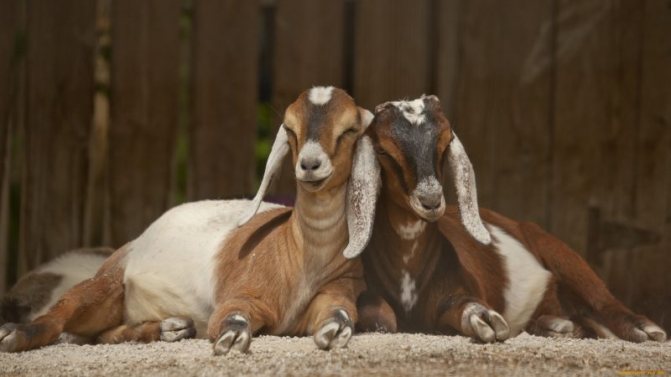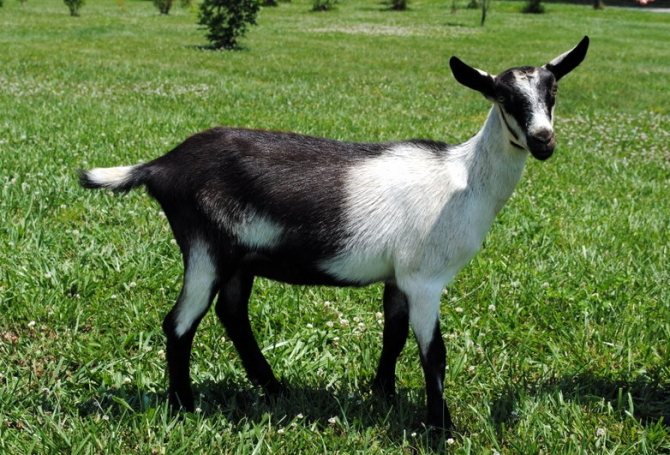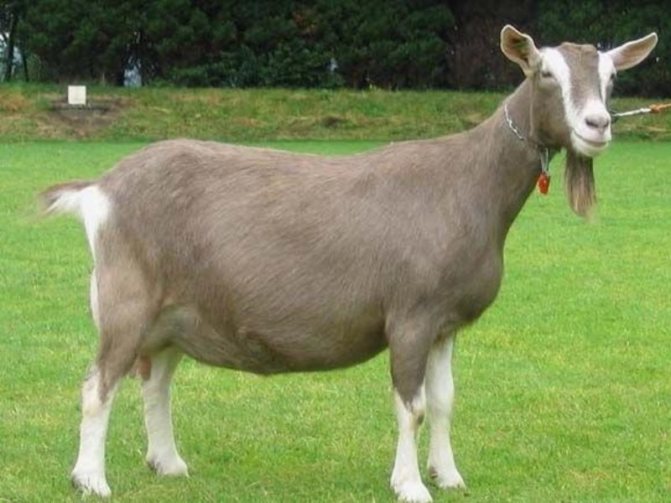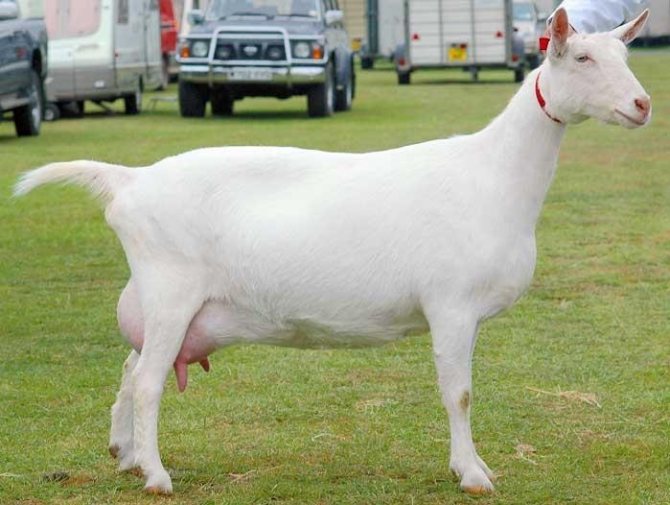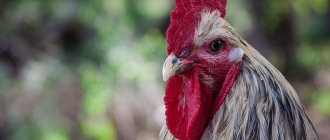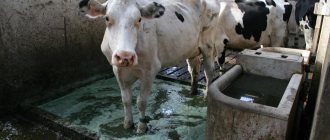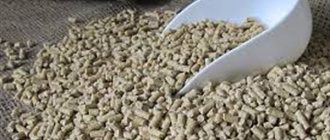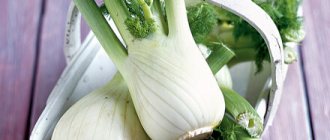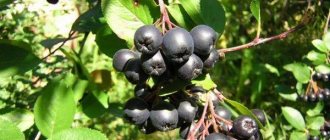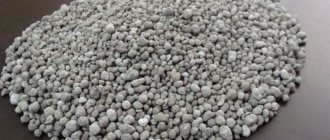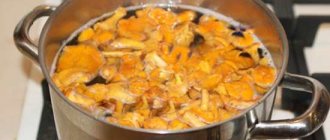The purpose of raising goats on farms is related to the production of a valuable and nutritious product - milk. It has been scientifically proven that it is goat's milk that causes the least number of allergies and is better absorbed by the human body. In addition, its nutritional value is higher than that of a cow product. At the same time, goats are less whimsical in care than cows. However, many people who love milk refuse to drink it, due to the fact that this liquid sometimes has a persistent specific goat smell. Nevertheless, they do not even suspect that the presence of such an aroma, which is not always pleasant, is inherent in far from all pedigree varieties of horned ones. Let's look at what breeds of goats are, dairy, odorless animals.
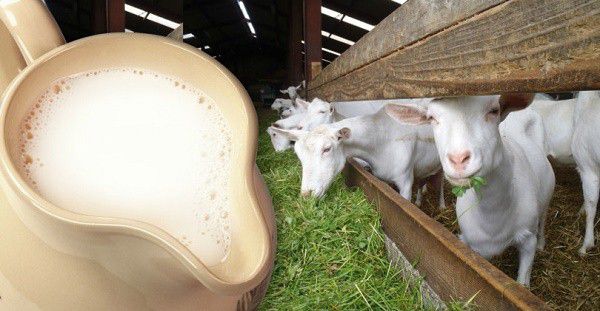
Odorless dairy goat breeds
Dairy goat breeds and their description
Toggenburg
Photo:


They owe their name to the Swiss valley. The growth of the animals is slightly less in comparison with the Saanen breed. An adult goat weighs on average about 50 kg, a goat can gain weight up to 70 kg.
During the lactation period, about 100 liters of milk are obtained from one goat. Fat index - 3-8%. The breed is multifarious, up to three kids are born in one lamb.
Goats are widespread throughout the world. Scientists in England and Holland continued breeding work, and now Toggenburg English and Dutch goats have been bred.
Zaanenskie
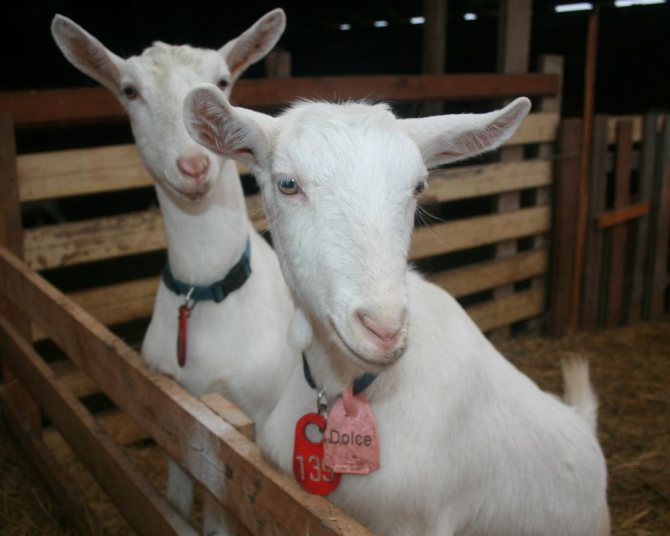

They are the highest yielding dairy animals. Animals have a strong constitution, can gain weight about 90 kg. A breeding goat can weigh almost a centner.
The lactation period is 11 months. Average milk yield is about 1000 liters in 365 days. There are representatives giving about 3 tons per year.
The products have a fat content of 3.7–4.5%. More than 200 kids can be obtained from hundreds of goats.
The breed is popular both in European countries and in America. Animals have a quick adaptation to different climatic conditions.
In our country, Zaanens are kept as improvers for crossing with other goats in order to obtain increased productivity, as well as for reproduction of a purebred herd.
Nubian
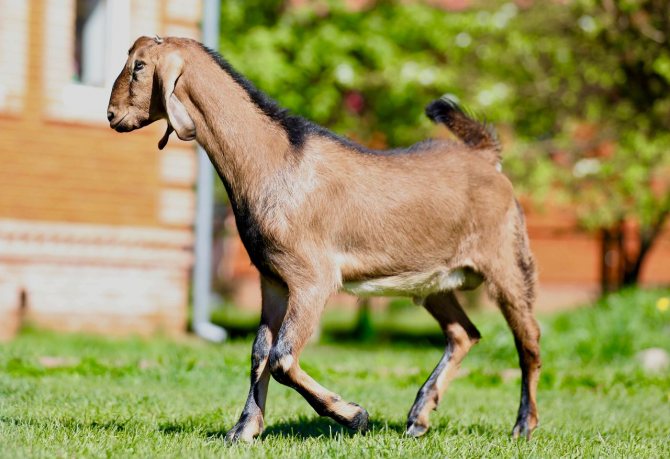

The sizes can be compared to the previous breed. Young growth is early maturing. Adult goats gain a mass of about 50 kg. From the first lactation from a Nubian goat, you can get more than 3 liters of milk per day.
Gradually, the indicator becomes higher and reaches 5 kg. For 365 days, about 1200 kg are received. Fat content - 4.5-8%. One goat can give birth to 2-3 kids. Some females kitten twice a year. Young growth is early maturing.
In our country, there are very few purebred goats, so the young are very expensive. It is preferable to breed Nubians on a small farm rather than a large farm.
It is important to remember that this milk yield must be kept separate from other goats.
Megrelian goats


The homeland of animals is in the western regions of Georgia. The breed is distinguished by two subspecies: lowland and upland. The former are characterized by short stature, low weight - on average, a goat weighs up to 35 kg, producers - about 50 kg.
The lactation period does not last long, approximately 200 days. Up to 350 liters of milk is obtained from one goat in 365 days, the fat content is 4.5%.
The upland type is larger. Females weigh about 42 kg, males 70 kg. For 6 months of the lactation period, up to 250 kg of milk is obtained with a fat content of 4.5%.
The products are used for the production of cheeses and fermented milk drinks. After the first lambing, the goats are not milked; they must feed the young. Megrelian goat gives one kid for lambing.
In the middle zone of our country, this breed is not bred. The conditions of the North Caucasus region, Crimea, Central Asian regions of Russia are ideal for them.
Gorkovsky
Photo:


The breed is considered a subspecies of Russian goats. They were bred using Zaanen and Russian breeds near Nizhny Novgorod. The average weight of a milking goat is about 50 kg.
The manufacturer can gain a mass of about 60 kg. Lactation lasts up to 300 days.
From one goat, they consistently receive about 500 kg. Goats are considered fertile and produce 2–4 kids. In addition to dairy products, wool is obtained from animals. The hide is used to make shoes.
Basically, the breed is bred near Nizhny Novgorod, in the Central Federal District, the Northern Volga region, Tatarstan, Chuvashia.
Russians
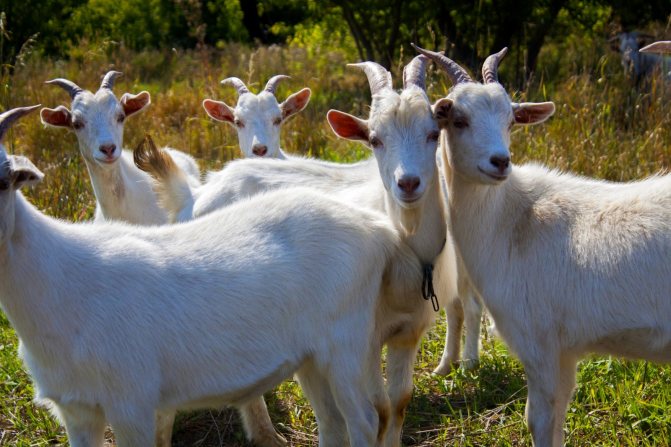

The animals were obtained by crossing the Zaanen, Toggenburg breed and Alpine goats. Widely distributed in the European part of Russia. Russian goats are of medium size and weight.
Females weigh about 40 kg, producers reach 60 kg. During the lactation period, which lasts 250 days, you can get 600 kg with a fat content of 4.5–5%. Up to 4 kids are born from one goat.
The breed is versatile. They receive not only milk, but also down and hide products, which are used for the production of chevro.
Cameroon
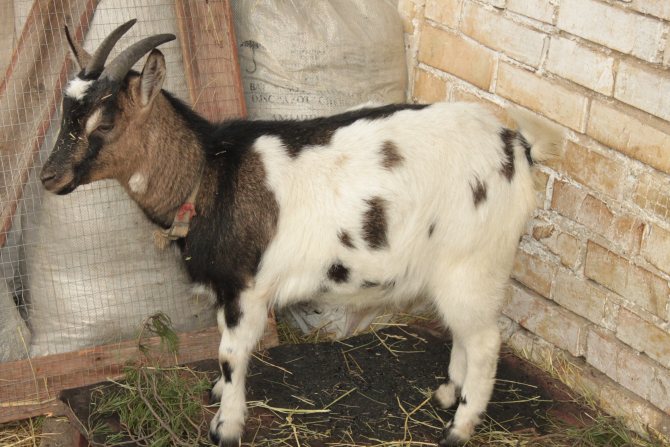

They are a dwarf form. They can be kept not only in the courtyard, but also in the apartment. Animals grow at the withers about 45 cm. The average weight of a goat is about 15 kg, goats are somewhat larger - up to 25 kg.
From one goat, you can get 1.5 kg of milk per day. Odorless dairy products with an average fat content of 5.3%. Milk is used in cheese making.
One goat can bear up to 4 kids. The average weight of a newborn is 0.4 kg.
Alpine
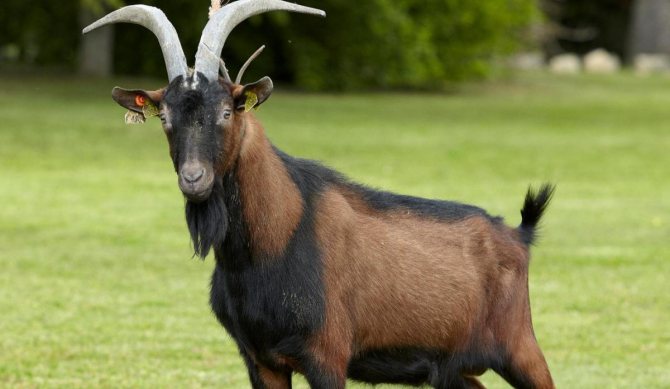

They belong to large animals. An adult goat weighs about 60 kg, the producer gains weight up to 80 kg. Dairy products from the Alpine breed receive 356 days. In this situation, the goat can give up to a centner of milk.
This indicator can be achieved when grazing animals on pastures for the entire possible warm period. The products have a fat content of about 3.5%.
When using the Alpine breed in crossing with other goats, young animals are obtained that surpass their parents in their productive qualities.
La Mancha breed


Descended from the Swiss and Nubians. Average weight is about 70 kg. From one goat receive 5 kg of dairy products per day. From the record holders get up to 8 kg.
In our country, the breed has spread in the south. It is recommended to breed goats when they reach the age of 18 months - females will delight the owner with multiple fertility up to 4 kids.
Czech brown
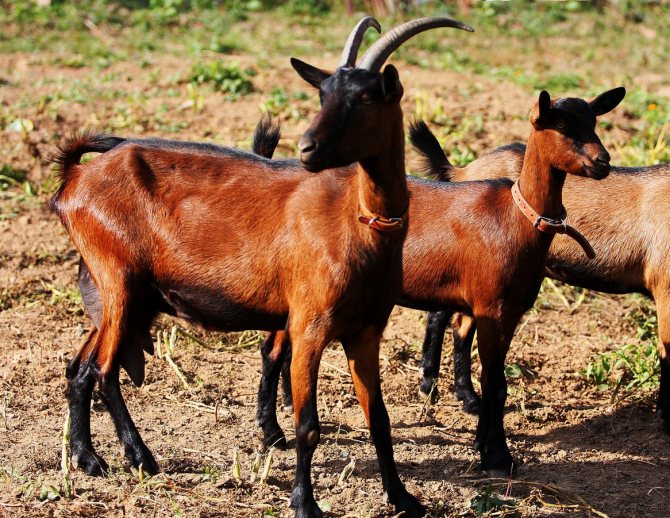

They are very large animals. A milk goat reaches a height of 75 cm and an average weight of about 60 kg, goats weigh 20 kg more.
From a thoroughbred female, you can get up to 6 liters per day with a lactation period of about 11 months. For one lambing, you can get up to 3 kids, which are distinguished by early maturity.
In our country, the breed has gained great popularity due to its ability to adapt to cold climates. There are breeding centers for breeding.
Dairy breeds have different indicators for milk yield, percentage of fat content and lactation period.
Barbary
Photo:
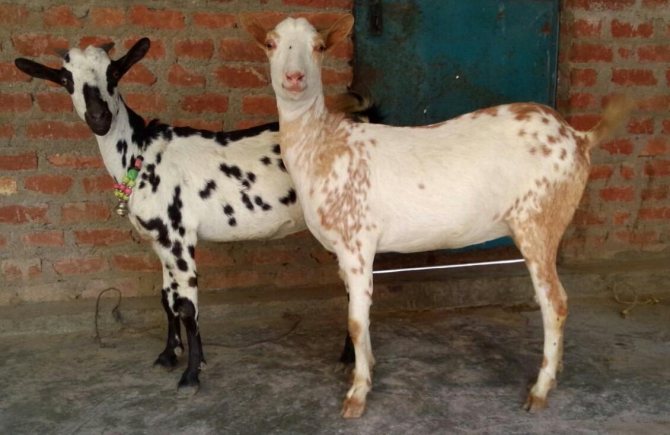

The Barbary Goat gets its name from Berber, a coastal town located in the Indian Ocean in Somalia.
The Barbary is one of the 20 classified breeds in India and is most commonly found in the northwestern arid and semi-arid regions. Barbary is a small, compact goat. The head is small and neat, with small ears and small horns.
Aboriginal breed of goats in India and Pakistan. The direction of productivity is meat and dairy.The color is often white with red spots, the coat is short, the ears are erect, the head profile is straight.
The live weight of goats at birth is 1.9 kg, weaning - 6.1, at 6 months - 8.7 and one year of age - 15.8 kg. The mass of adult goats is 35-47 kg. In goats, these figures are respectively 1.7; 5.7; 6.0; 11.1 and 17-28 kg.
The mortality rate of goats reaches 25%, of goats - 31.4%. The age of the first goat is 14-16 months.
The average milk productivity in the first lactation is 632 g / day, in the second month - 638 and in the third - 541 g / day. For 210-252 days of lactation, 150-228 kg of milk are obtained.
Fat content of milk 3.94-4.67%. Fertility is high, triplets are not uncommon. The animals make good use of the poor pastures.
Bital
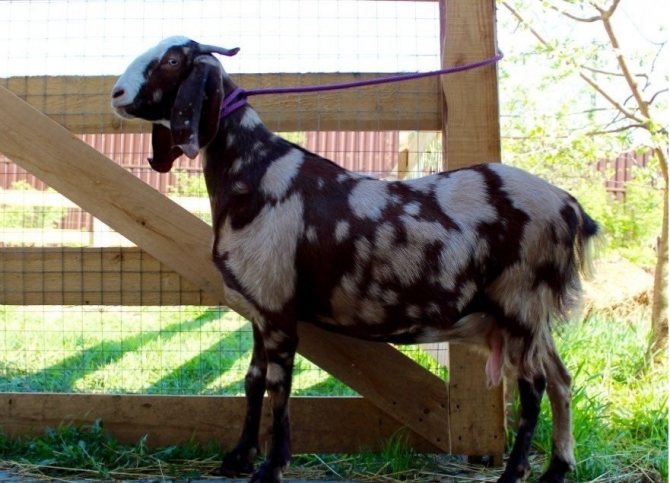

Aboriginal breed of goats in India. Bred in the states of Rajasthan, Punjab. The direction of productivity is dairy. The color of the coat is very diverse. Live weight:
- goats at birth 2.9 kg, weaning - 10.2, at 6 months 12.7, at 1 year - 22.2, adults - 40-74;
- goats, respectively, 2.7; 9.0; 11.5; 16.6; and 27-36 kg.
Average milk production for 161-172 days of lactation is 105-168 kg. Record milk yield 834 kg.
The fat content in milk is 5.03%. The age of the first goat is 77-120 weeks, the intervals between goats are 282-386 days. 1.91-1.7 kids are obtained per uterus. In total, there are more than 800 thousand goats of this breed.
Westland
Norwegian goat breeding consists mainly of the Norwegian dairy goat breed with about 38,000 dairy goats.
The breed originates from the northern European group of goats and has recently been less influenced by foreign breeds, with the exception of some crosses with Saanen and French Alpine.
Aboriginal breed of goats in Norway. They are bred on the southwest coast. The direction of productivity is dairy.
The color is bluish-white. Live weight of goats up to 90 kg, goats - 40-60 kg. Annual milk yield is 400-500 kg, milk fat content is 3.5%.
Garganica
Aboriginal breed of goats in Italy. The direction of productivity is dairy. The kids are born black, then they acquire a chestnut color. Goats have long, straight, helical horns.
Garganica weigh about 35 - 40 kg and Garganica goat about 55 - 65 kg. Garganica goats can reach a height of 75 cm, and goats up to 85 cm.
Garganica goats, during the lactation period, give from 200 to 250 liters of milk per year.
Goats of this breed are usually bred because of their reliability and high vitality. Garganica goats adapt easily to difficult habitats.
Guadarramena (guadarrama)
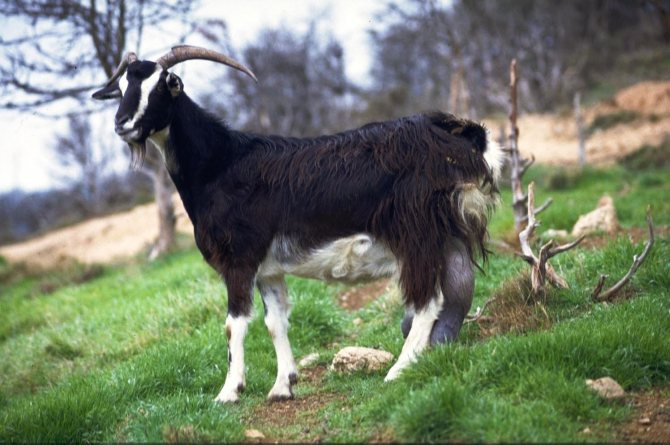

Aboriginal breed of goats in Spain. It is bred in the central part of the country. The direction of productivity is dairy. The color is dark, the coat is long, the goats are horned and hornless.
Within the breed, there are meat and dairy types. The height at the withers is 75-86 cm for goats, 65-75 cm for goats. The live weight of goats is 63-70 kg, for goats 48-55 kg. For 210 days of lactation, 250-350 kg of milk are obtained.
Damas
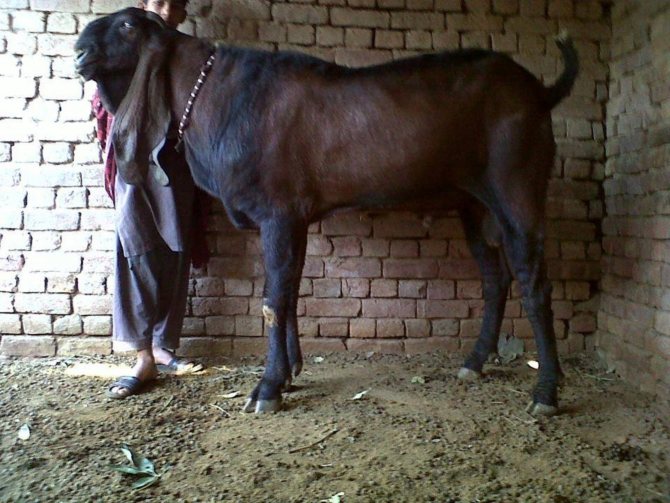

Breed of dairy production direction. These goats are bred in Syria and Cyprus. The color is red or brown, also variegated or gray, the hair is long, spiral-shaped in goats, sickle-shaped horns in goats, the udder is well developed.
Live weight of adult goats is 55-65 kg, goats - 70-90 kg. Goats reach sexual maturity at the age of 7-10 months. Average milk production 520-558 kg, fertility 176%. The live weight of the kids at weaning is 27 kg.
Gold Guernsey
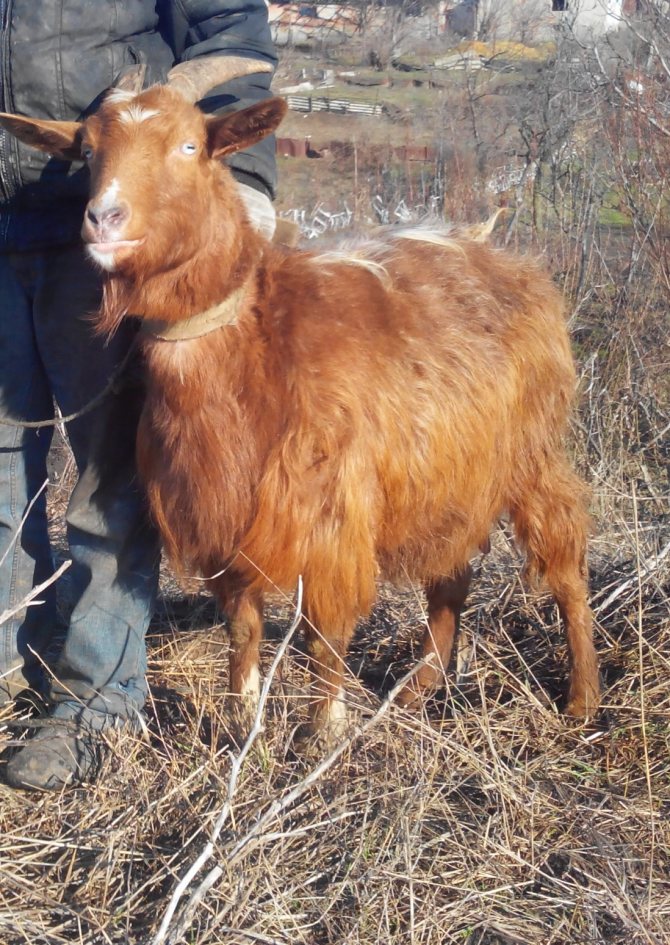

This breed has been known in Great Britain since the beginning of the last century. On the island of Guernsey, amateurs selected golden goats. The exact origin of the breed is unknown.
The direction of productivity is dairy. They are small, beautiful animals that use food well. The annual milk yield is about 700 kg, the fat content of milk is 3.8%, the protein content is 2.87%.
It is believed that the ancestors of Golden Guernsey were Oberhasli and Syrian breeds. The first recorded reference to Golden Guernsey in its current form dates back to 1826, when a reference to the "golden goat" was printed in a guidebook.
Kamori
Aboriginal breed of Pakistani goats. The direction of productivity is dairy. Bred in dry areas. Animals of strong constitution, from them get good quality carcasses. The udder is well developed.
Daily milk yield 2-4 kg. Height at withers in goats is 86 cm, live weight is 50 kg.
Nejskie
The native breed of Iranian goats. The direction of productivity is dairy.Animals are kept indoors in the coastal regions of the country.
Production of commercial milk is about 350 kg. In total, there are about 5 thousand goats of this breed.
Orospedana


It is one of the most common goat breeds in Spain. Bred in 1952. Direction of productivity - dairy. It is recommended to breed this breed in Mediterranean and Latin American countries.
With intensive breeding, the offspring is obtained at 12 months. Beating the kids from their mothers is carried out when they reach a body weight of 8-10 kg. There is no data on the current state of the breed.
Partbatsar
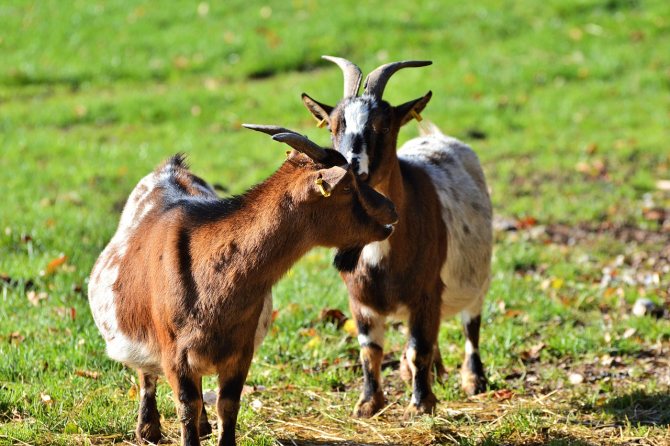

Indigenous goat breed of India, bred in the state of Rajasthan. The direction of productivity is dairy. The color of the hairline is from light brown to dark chocolate, sometimes there are white spots on the body.
The hair is short, shiny, in goats it is somewhat coarser and longer than in goats. The ears are long, drooping. Both sexes are horned. The horns are 5-8 cm long and directed backwards.
The height at the withers of the goats is 75-80 cm, the body length is 80-85 cm, the body weight is 35-40 kg; in goats, respectively, 70-80, 70-75 cm and 30-40 kg. The mass of goats at birth is 2.4 kg, of goats - 2.0, with a beating at 6 months, respectively, 12.36 and 9.66 kg.
Milk production in the first 8 weeks of lactation is more than 1 kg / day, lactation duration is 175-185 days.
Milk production for 180 days of lactation is 131.9 kg. Milk contains: fat 5%, dry matter - 24.57, protein - 3.31, lactose - 4.31%. Animals are not resistant to diseases.
Nubian goats
It is believed that the very first man tamed this breed. Nubian goats have lived next door to humans for seven and a half centuries. They have the same name with the desert in the Republic of Namibia.


The appearance of the representatives of this breed of animals is considered bizarre because of the large bell-shaped ears, which are always lowered, and the long nipples on the female's udder. Although the Nubian goats seem graceful: the legs are flexible, the neck is long, the body is slender.
The breed is distinguished by its coat color, which can be brown, black, bay or white, and sometimes spotted. Goats have an increased temperament. They are characterized by restlessness, exactingness, perseverance.
Animals respond to human care and are happy to contact him, although they show aggression towards other individuals of the herd: they begin to bully and butt, feeling confident in their abilities. When caring for animals, you need to be strict with them, otherwise they will become naughty and it will be difficult to cope with them. It is better if there are no other breeds of goats in the herd.
The meat breed of goats is becoming more and more popular. Its representatives are often purchased by breeders today. This is due to the high profit margins. From one individual, you can help out one hundred twenty and more than a thousand rubles. Tender meat is bought quickly, and milk with a high fat content is suitable for making delicious cheese.
How to choose?
In order for animals to please with high productivity, when choosing them, you need to be guided by the following knowledge:
- age category;
- compliance with breed characteristics;
- indicators of milk characteristics;
- physiological features;
- similarity with parents.
For successful reproduction, preference is given to young goats, which have a proportional body composition.
The limbs should be straight, the body should be elongated, resembling a barrel from the side, the dorsal region should be wide, the coat should be smooth, uniform, the udder should be elastic.
When choosing dairy goats, you need to take a closer look at the shape of the udder, it should be pear-shaped with nipples of medium length, while they should be well developed.
Long teats represent a number of difficulties that can arise during milking. A loose udder is a sign of poor milkiness.
When purchasing a reproductive herd, you can try to milk goats. After this process, the udder falls off, if this does not happen, you should refuse to buy the animal.
Dairy goats have an elastic udder, it should not be sealed. During trial milking, it is possible to assess how high-quality products are provided by animals.
It is recommended to keep one breeder per 50 goats in a domestic herd.
You need to choose a goat competently. The animal must have a good pedigree, it is she who will affect the productive qualities of future offspring and the health of the kids.
The sire must be changed every few years so that inbreeding does not occur, as a result of which the offspring degrades. You can keep a couple of producers and carry out a parallel crossing.
What determines the choice of an odorless dairy goat breed?
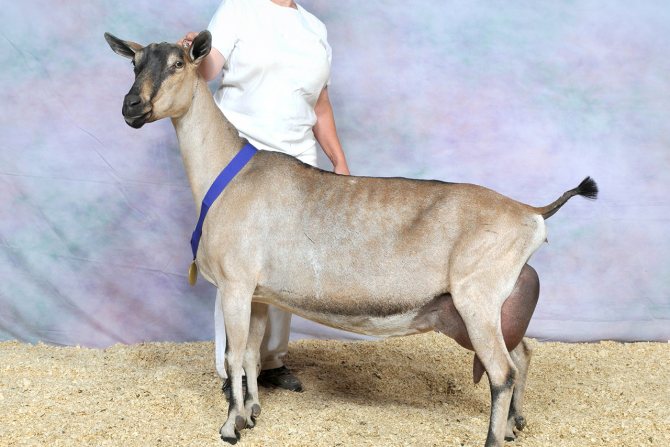

Some animals are unable to withstand temperature extremes or certain climatic conditions.
Other breeds require keeping exclusively indoors.
Under the wrong conditions, the productivity of animals is significantly reduced. This is what complicates the choice of dairy goats.
It is advisable to first familiarize yourself with the characteristics, breed standards and features inherent in a young livestock. For cultivation, it is necessary to choose local subspecies of small ruminants.
During their lifetime, they managed to adapt to the climatic conditions of the surrounding area. Also, the microflora of the stomach in small cattle can lead to some problems with the digestibility of feed when changing the diet.
Therefore, it is advisable to take animals that are adapted to feed on local pastures. Thus, the risk of dysbiosis is excluded.
It is cheaper to keep goats that have adapted to the conditions of the surrounding area than breeds brought from elsewhere.
Animals are able to graze in the summer season on any free pastures.
Thus, there is no need to purchase combined and roughage necessary for the standard. For the winter diet, it is possible to harvest grass cut on site.
General characteristics of meat breeds
Residents of Europe appreciated the benefits of goat meat earlier than the Russians, however, in our country, people have recently begun to eat goat meat. The demand for such meat products has increased. It became necessary to develop this branch of animal husbandry. Meat goats are raised on many Russian farms. Goat meat, which has a beneficial effect on human health and the human body, has the following advantages:
- rich in fats and therefore nutritious;
- known for its dietetic nature and not too high calorie content;
- contains nutrients necessary for the normal functioning of the body, which is suitable for both children and adults;
- soft and low-fat, since there is more water in the meat of this animal than fat;
- tastes better than pork or beef.


In small horned representatives of meat breeds, there are common features by which you can distinguish such a goat from other breeds.
- The main feature of these animals is a large, fleshy body and wide bone.
- The muscles of the "meat" pets are well developed, and the legs are strong enough to withstand a massive body.
- In newborn kids of such breeds, the weight is added by about 300-500 grams per day. Females are characterized by a body weight of up to 85 kg, and males - up to 100 kilos.
- The quality and length of wool is different and depends on the region in which the meat goats are raised.
- Another feature is the simultaneous birth of two or three cubs.
Features of the content
Most dairy goats are unpretentious in care, but they all do not tolerate dampness and drafts, do not like severe frosts. Pay attention to this point when setting up a barn.
Valuable tips for setting up a barn:
- Insulate the floor, otherwise the animal will get sick.
- Close all cracks, exclude the entry of rodents.
- Regularly disinfect the room from harmful insects
- Keep the barn clean and tidy.
- Control the air temperature, the optimal range is 3-5 degrees.
- Provide each goat with an individual drinker and feeder.
Features of nutrition and care:
- Refresh the water in the drinking bowls 2 times a day, more often in the summer. Expect 1 goat to drink 8-10 liters of water per day.
- Do not leave stale hay in the trough.
- When choosing a grazing site, make sure the area is free of harmful grasses.
- Avoid walking in bad weather, strong winds.
- Provide water and shelter for free grazing.
- For free grazing, set up an aviary with a high fence.
Goat meat - inexpensive, tasty, healthy
Raising kids on your own is easy, especially if you have a dairy goat. The first month and a half she will feed the kid herself, then it is gradually transferred to whey, grain and hay / grass. If you buy a goat specifically for fattening, choose the strongest, well-fed, at least 2 months old. and weighing at least 10 kg.
In terms of taste, goat meat is not inferior to mutton and has a characteristic flavor. Dairy goats up to 3-4 months, goats up to 5-6 years old are sent for slaughter. Older dairy goats have tough meat, so it is best used for boiling, stewing or making chopped meals and convenience foods. Meat of dairy goats older than 4 months. can have a pungent odor, so it is preferable to slaughter them before puberty (up to 5 months) or castrate at the same age and then fatten.
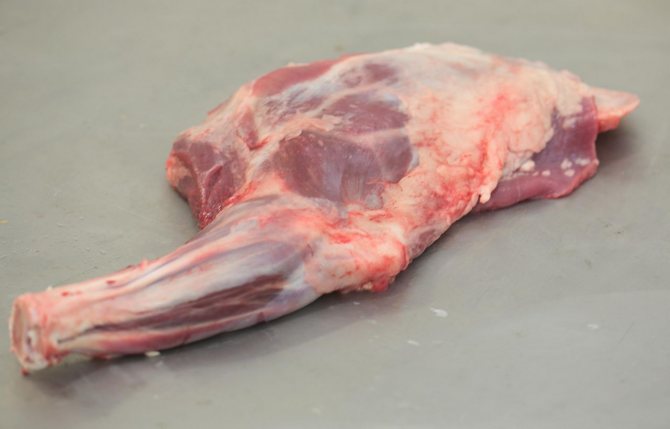

Goat meat hind leg
Vitamins, minerals and fatty acids that make up goat meat have a positive effect on the human body. Goats very rarely suffer from parasitic diseases, therefore, there are practically no helminths and other parasites in their meat.
Goat meat is recommended for people with diseases of the cardiovascular system and weak immunity. Due to its high digestibility, goat meat is useful for children, pregnant and lactating women and the elderly. Due to the high content of vitamin B4, which protects the liver, goat meat is advised to be eaten by patients with cirrhosis, hepatitis and other liver diseases. For this reason, it is also beneficial for those who abuse alcohol.
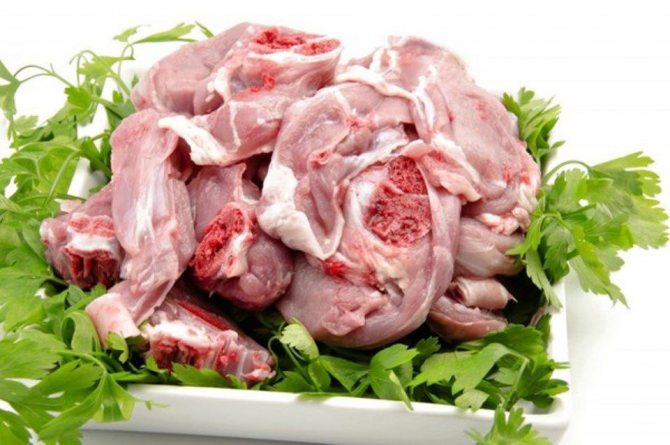

Goat meat - low calorie dietary meat
Regular consumption of goat meat helps to restore connective tissue, therefore it is recommended for people with herniated discs or other diseases of the spine.
Goat meat normalizes blood pressure in hyper- and hypotensive patients.
Meat composition of other domestic animals
Goat meat contains less fat than lamb and pork. This meat with thin fibers is bright scarlet, brighter than lamb. There is no fat between the muscles in goat meat, there is also little under the skin, therefore, goat meat is dietary, with a low (1 g per 100 g of raw meat) cholesterol content.
Goat meat contains up to 77% moisture, so it is juicy and low-calorie. Pork contains 50-60% water, 71% beef, 72% lamb.
Average calorie content of meat of different types of animals
| Type of meat | Calorie content, kcal per 100 g |
| Goat meat | 120 |
| Beef | 254 |
| Pork | 355 |
| Mutton | 258 |
| Rabbit | 199 |


Goat meat in the oven
For comparison: goat meat contains on average 2-3%, veal 7.5%, beef 10-16%, pork 22-30%, mutton 8%.
Who will benefit from goat meat and who will harm
In reasonable quantities, goat meat is good for everyone - children, adults, the elderly, pregnant and lactating women, athletes. Meat is rich in protein, therefore, with high physical activity, its amount in the menu can be increased by 20%. Protein is especially important for growth, so lean meat is good for children, pregnant and lactating women.
Goat meat contains less fat than lamb, pork and beef, so it is easier to digest. This is a dietary meat, so it can be eaten even by those who are on a low-calorie diet or poorly tolerated meat from other types of animals.
From goat meat, you can independently make baby food for children under one year old.To do this, it is better to use the meat of young castrated goats - it is guaranteed not to have a characteristic smell, tender and juicy.


Hot smoked goat meat
It is also useful to add goat meat 1-2 times a week to the diet of elderly people with heart and vascular diseases, diabetes and problems with the musculoskeletal system. Due to its high nutritional value, goat meat provides enough energy and is easy to digest. The vitamins and minerals contained in it will help bring blood pressure back to normal, satisfy appetite and do not increase blood sugar levels.
Goat meat can be an excellent alternative to rabbit or poultry meat - it is low in calories, low in fat and well absorbed. Goat meat is useful for everyone, especially athletes and those who want to lose weight without hunger strikes and a strict diet.
Goat meat has only one contraindication - individual intolerance.
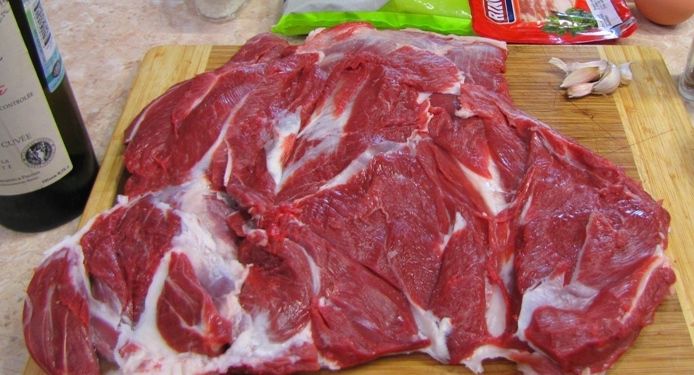

Tender goat meat
Nutritional and culinary value of goat meat
Goat meat - juicy meat, it contains a lot of moisture - 76-77%. In 100 g of the pulp of a young goat (8-10 months) 21-22 g of protein, 2-3 g of fat, 1.2% - minerals.
100 g of goat meat contains a lot of vitamins and minerals:
- vitamin E - 0.5 mg;
- vitamin B1 - 0.05 mg;
- riboflavin (vit. B2) - 0.2 mg;
- niacin (vit. B3) - 4.9 mg;
- pyridoxine (vit. B6) - 0.4 mg;
- choline (vit. B4) - 69 mg;
- pantothenic acid (vit. B5) - 0.5 mg;
- folic acid 7.8 mcg;
- vitamin B12 1.9 mcg.
Mineral composition of goat meat
| Mg per 100 g of goat meat | Mcg per 100 g of goat meat | ||
| Calcium | 11 | Copper | 181 |
| Iron | 3 | Iodine | 7 |
| Magnesium | 20 | Chromium | 9,9 |
| Phosphorus | 199 | Fluorine | 64 |
| Potassium | 326 | Molybdenum | 11,9 |
| Sodium | 64 | Cobalt | 7 |
| Zinc | 3 | Nickel | 10 |
| Chlorine | 60 | Tin | 13 |
| Sulfur | 231 | Manganese | 35 |
What affects the taste and smell of goat milk?
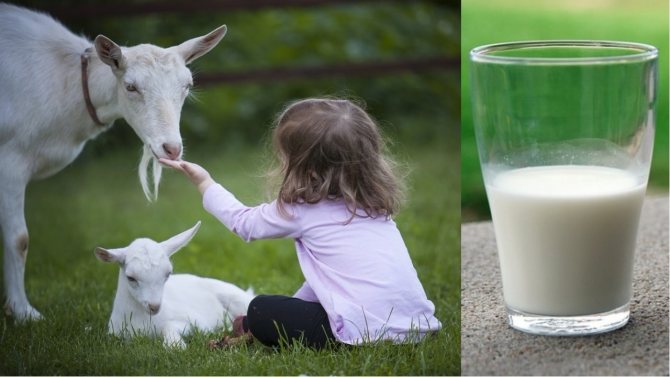

It should be noted that the taste and smell of goat milk is influenced not only by the breed factor, but also by:
- conditions of keeping the animal;
- feeding the goat.
Compliance with the hygienic standards of keeping the animal
Indeed, if the animal itself is untidy, rarely washed, and even its udder is not wiped before milking, the milk will surely smell like a goat, and besides, it will contain harmful bacteria.
It is strictly forbidden to drink such a liquid in its raw form, since you can become infected with many diseases, but it is not boiled that it tastes most pleasant.
Udder washing
In order to prepare the udder of the goat for collecting milk, as well as to remove various contaminants and bacteria in them from it, it is necessary to wash it before the milking procedure.
It is carried out using: warm water; soft sponge; dry towel.
Thoroughly wet the sponge and gently rinse the goat's udder all over the surface to remove any dirt. A completely clean udder should be doused with warm water again, and then wiped dry with a towel.
Udder massage
Massage is not related to udder hygiene, but it also has a significant impact on milk quality. It consists in massage of the lobes of the udder, carried out in turn.
Russian white breed
Bred as a result of selection on the territory of Russia. Representatives of this variety usually have a monochromatic coat. Goats are distinguished by their strong, but at the same time, quite proportional physique.
The growth of females is about 80 centimeters, weight is about 50 kilograms. Dairy goats of this breed can be hornless, but horns are also possible.
Productivity during lactation varies from 500 to 800 liters. The fat content of milk is from 4 to 5%. The population on the territory of Russia is more than 1,000,000 individuals. You can buy breeding animals without much difficulty, the price is from 3000 rubles.



